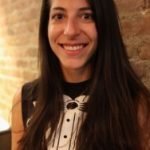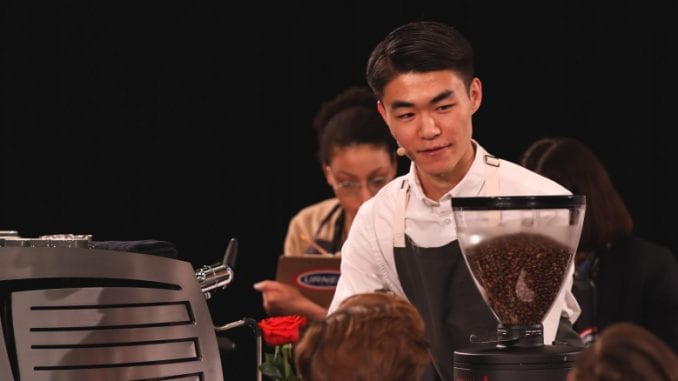
Third-place USBC finisher Kay Cheon talks about his accomplishments as a first-time competitor, as well as his approach to taking risks, building delicious drinks, and breaking out of his comfort zone.
BY ASHLEY RODRIGUEZ
BARISTA MAGAZINE ONLINE
Photos by Jake Olson
Kay Cheon, barista at Dune Coffee Roasters in Santa Barbara, Calif., and regular contributor here at Barista Magazine, had never competed in a barista competition before this season. But in late April, he placed third at the 2018 United States Barista Championship. In this interview, Kay talks about what he struggled with, the innovative techniques that helped him win, and what his plans are for the future.
Ashley Rodriguez: Since you’re a first-time competitor, I’m sure you learned a lot as you went, especially from the first competition in Rancho Cucamonga [Calif.] until the United States Barista Championship (USBC). Can you tell us about some of the things you learned and some of the struggles you faced?
Kay Cheon: I think barista competition, like any other competition, is mostly about competing against yourself, so competing in Rancho Cucamonga, to Reno, to Seattle, all helped me with my mental fortitude and stress management. I remember I was worried sick about my script at Rancho Cucamonga, so I would walk around in public saying my script out loud to myself.
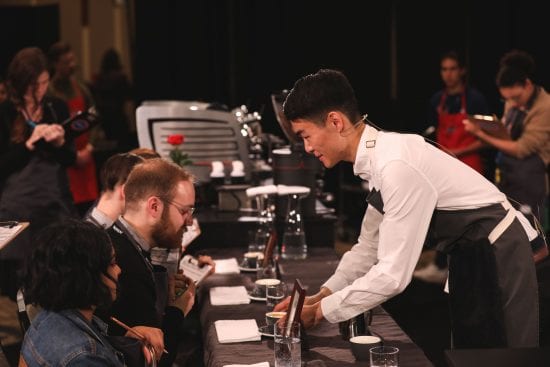
At some point, I realized that it’s more important to believe in what you’re saying and be able to say it whichever way. All the way up to Seattle, I definitely had thoughts about just backing out, but I knew I couldn’t live with myself if I did that. The worrying and planning was always present, but I got a lot better at controlling my emotions and thoughts. Lots of meditation, forcing myself to take breaks, controlled breathing, etc.
AR: Tell us about your coffee.
KC: I used a coffee from Juan Peña, a producer from Ecuador, in Seattle, but I used a small-producer Colombian coffee (Javier Cantillo) in Reno. It’s really exciting to me because Cole [McBride, 2018 USBC winner] used a natural from Juan Peña, which means that the same producer’s coffee was featured twice in the finals of USBC.
For qualifiers in Reno, we thought about what coffees were fresh at the time, and which ones had potential should I move on to nationals, as well as being balanced and working as straight espressos and in a sig drink or in milk. We had one bag of the Javier Cantillo that Cafe Imports sourced for us, but we roasted through all of it for Reno, so using it in Seattle became out of the question. We took in different samples from different importers for Seattle, but again Cafe Imports came through with the Juan Peña sample and it blew all of us away.
I remember coming in to the lab the day after the roastery team had cupped it, and they were all but insisting I use that coffee for competition. We also learned our lesson this time around and had more than a single bag to play with. About three weeks out, we landed on the roast profile that we ended up using, which was a bit of a change from what we had been doing, focusing on the drying and Maillard phase a little more, but it balanced a lot of the acidity in the coffee while still being super transparent with terroir flavors.
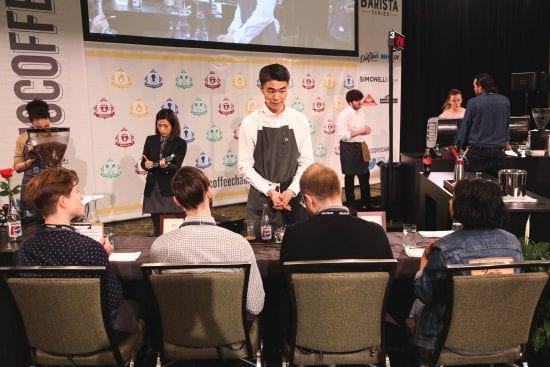
AR: You did a really cool thing by freezing your milk and removing some of the water to make it super concentrated. Tell us about this process and how it complemented your coffee.
KC: I got the idea from watching Ben Put, the Canadian barista champ, as well as Hugh Kelly (Australian barista champ) and other competitors doing different things with the milk course. It’s really cool because I was kind of skeptical about it at first, but the taste difference is pretty drastic. I tried this with different milks, but the Strauss 2 percent milk tasted the best to me, as well as being the best pairing with coffee. It did mean that we wanted to use our own milk in Seattle, so we had a cooler full of dry ice and milk jugs that we checked at the airport.
I basically just froze the milk bottles, then cut into the bottles and let them thaw into a big container, measuring the weight of what was left frozen in the bottle and what had melted into the container. After that, I tasted the milk to adjust, since the measurements wouldn’t be precise every time. Talking to Ben was also really inspiring because he was saying how he wanted to use a method that would be accessible for anyone, without requiring special equipment or investment. I was also blown away by his offer to come and taste before my finals routine after talking to him on the trade show floor.
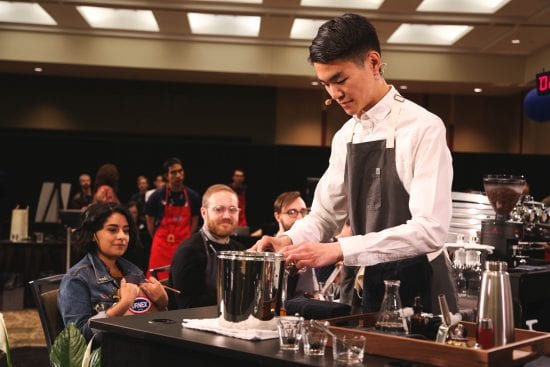
AR: What motivated you to compete to start with? What kept you motivated leading up to competition?
KC: I always wanted to compete, but it always seemed so unattainable, especially when you see a lot of these larger-than-life competitors who have been doing this for years. For me, it was definitely a personal challenge to get out of my comfort zone, with the public speaking and presentation aspect of it probably giving me the most trouble. Part of it was also not wanting to let anyone that had invested in me down, and doing work that I could be happy putting my stamp on and saying that I gave it my best effort.
Competition is also a fun way to talk about coffee in a different way with people. My girlfriend has family from Ecuador that I set aside some coffee for, and there are countless store employees [in my neighborhood] who now know there is such a thing as barista competition because I would go in and buy all of these weird things to use. I love that part of it where you can use it to demonstrate that there’s something special about coffee, something that you’re investing heavily into and believe strongly in.
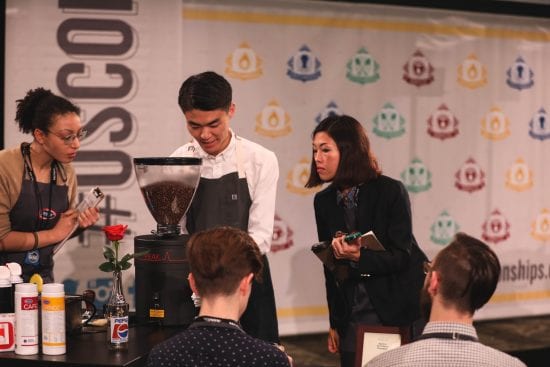
AR: What message were you trying to send to the judges as you gave your routine?
KC: Both at preliminaries and at qualifiers, I think my script was sort of my own message, and I treated the judges as a passive audience. But, both in competition and in a real service environment, that’s not the best way to engage people. I wanted to make sure that my judges and audience were comfortable with what they’re doing, and that I was able to understand their duties and match what I was doing to what they needed to do. Scoring is hard; it’s not like the judges are just sitting there and drinking coffee or watching you grind coffee—they take their jobs seriously and they’re putting in effort during those 15 minutes, just like the competitor is.
I wanted to take away as much uncertainty as I could, while demonstrating proficiency in what I was doing to reassure them that their drinks and service would be as great as I could deliver. Just like in the café, if you’re able to demonstrate to your guests that you know what you’re doing and that you’re aware of your guests’ needs before they are, that’s how you deliver great service. I can’t say that I pulled all of that off perfectly in competition, but that was my intention at least.
AR: Can you tell us about your signature drink?
KC: My signature drink was a play on cherry cola, closer to a Roy Rogers actually. I had all these lofty ideas straight out of Dave Arnold’s Liquid Intelligence for my sig drink, but frankly they didn’t taste very good, nor did they actually work with the coffee. After making a mess in the lab one day, I decided to do something simpler that would actually work flavor-wise with Juan Peña’s coffee.
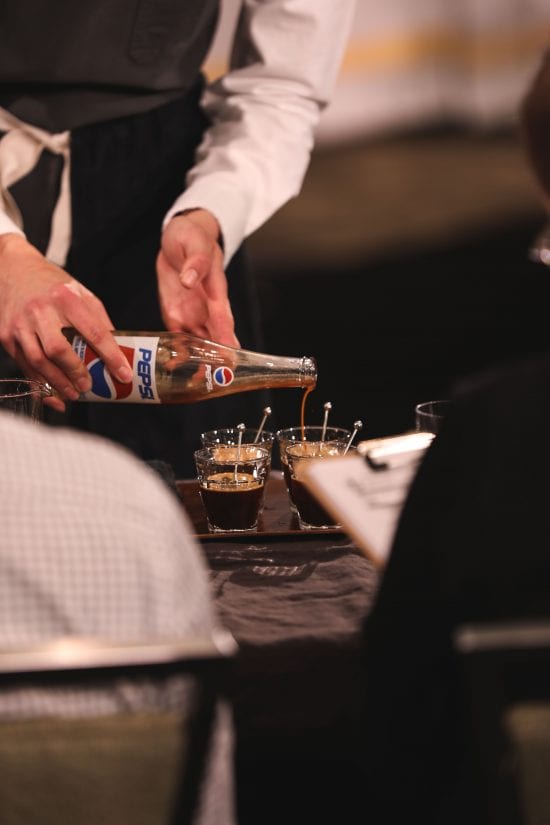
I made a cola base for the drink on stage with brown sugar and some spices, just like how Coke and Pepsi have those flavors, then added some grenadine that I made for a similar flavor to cherry, without explicitly using cherry. Then I mixed in the espressos with all of that and served it out of a Pepsi bottle for some visual cues. I mentioned this in my routine too, but I liked the idea of doing a drink that someone who had never tasted this coffee would be able to relate to, and see the flavor parallels in a unique coffee.
AR: Will you compete again?
KC: I’m a little scared that I set the bar pretty high for my first year of competition, and I’d feel awful if I compete next year and don’t do as well or better, but I wouldn’t say that being the national champion is my ultimate goal. What I really want to develop through competition is a deeper understanding of our industry, as well as being able to communicate those understandings better. My two competition heroes, hands down, are Andrea Allen and Charles Babinski, both in the way they deliver their message through competition as well as just absolutely kill it in their service. So for me, standing in the same lineup as Andrea Allen made me feel like a winner.

